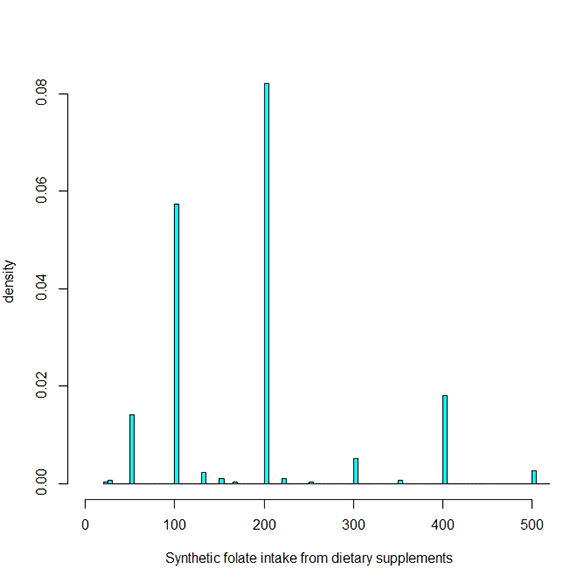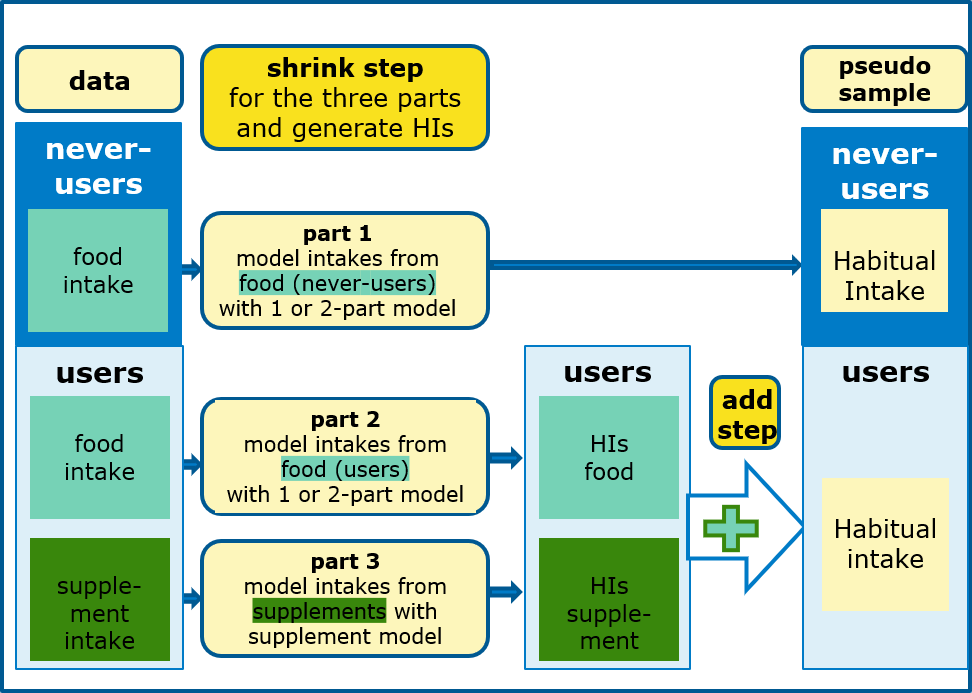SPADE consists of several modelling options, depending on the sources of the dietary components.
4 options
The modelling features are described in more detail:
- 1-part model:
To estimate dietary components that are consumed on a daily basis by almost all participants - 2-part model:
To estimate dietary components that are consumed episodically - 3-part model:
To estimate total nutrient intake from foods and dietary supplements - Multi-part model:
To estimate total intake from multiple food sources
1-part model
The 1-part model is intended to estimate the habitual intake distribution of food components, foods or food groups that are consumed daily by (almost) all subjects. This means that in the study population (almost) all subjects have a non-zero intake on two observed days.
The SPADE 1-part model consists of the following steps:
- Transform observed data to a normal distribution
- Model intake as a function of age and remove the within-person variability resulting in a shrunken distribution at the transformed scale
- Back-transform shrunken distribution to the original scale
Figure 1: This model requires intake information measured on at least two days (e.g. 24 hr recalls)
2-part model
The 2-part model is appropriate to estimate the habitual intake distribution of food components, foods or food groups that are consumed episodically. The observations can typically be divided into three groups: subjects with positive intakes on both days, subjects with only one positive intake and subjects with zero intakes on both days. If no further information is available, e.g. from a food frequency questionnaire, all subjects are assumed to be potential consumers. If information is available on the never-consumers in the survey, SPADE can take this information into account.
The SPADE 2-part model consists of the following steps:
- If applicable, select the never-users and assign them a habitual intake of zero.
- The modelling step for the probability of consumption (part 1):
- Estimate the probability of consumption as a function of age. - The modelling steps for the amounts on consumption days (part 2):
- Transform observed amounts on consumption days to a normal distribution
- Model intake amounts as a function of age and removal of the within-person variability
resulting in a shrunken distribution at the transformed scale
- Back-transform shrunken distribution to the original scale. - The habitual intakes are derived as the probability on consumption (part 1) multiplied by the habitual intake amount on a consumption day (part 2), which are obtained by a Monte Carlo simulation.
This model requires intake information measured on at least two days (e.g. 24 hr recalls)
2-part model for intake from dietary supplements
Figure 2: The synthetic folic acid intake from dietary supplements is spiked.
In some cases the distribution of observed intake may be spiked, for example in cases of supplements. Therefore, an alternative 2-part model is needed.
This model consists of the following steps:
- Select the never-users of supplements and assign them a habitual supplement intake of zero.
- Estimate the probability taking the supplement as in the 2-part model for foods and food components for the potential users of this supplement.
- Estimate the habitual intake for the users:
- For subjects with two observed non-zero intakes from dietary supplements, the habitual intake amount is set as the mean intake over both days, since for most subjects with two non-zero intakes, these intakes are the same.
- For subjects with only one observed positive intake from dietary supplements, this single positive value is used as the habitual intake amount.
- For the remaining subjects, the potential dietary supplement users with two zero intakes on both survey days, a habitual intake amount is predicted with a regression tree model based on the data of all subjects with a habitual intake amount. - The habitual intakes of a component from supplements among supplement-users are obtained by multiplying the probability taking the supplement with the habitual supplement amount on a day using pseudo persons.
This model requires information on intake from dietary supplement measured on at least two days (e.g. 24 hr recalls) and eventually information on use of supplements
3-part model
The 3-part model estimates the habitual intake from foods and dietary supplements. This model is based on the first shrink then add approach. It consists of the following steps:
- Estimate first the habitual intake from foods only separately in never supplement users (part 1),
- Estimate the habitual intake from foods only in supplement users (part 2)
- Estimate the habitual intake from dietary supplements (part 3).
- Obtain the total habitual intake: pseudo persons are generated by Monte Carlo simulation for the three parts. Thereafter, for the supplement users, the habitual intakes from foods and from supplements are added per pseudo person (the add step).
- Obtain the complete habitual intake distribution by joining the habitual intakes from the pseudo never-supplement-users with those from the pseudo supplement users.
Figure 3: 3-part model
This model requires information on the intake of foods and dietary supplements measured on at least 2 number of days (e.g. 24 hr recalls) and information that identifies is a participant is an ever or never-user of dietary supplements.
Multi-part model
The first shrink then add approach may also be required to estimate the habitual intake distribution from several food sources. An example is the estimation of habitual intake of a specific compound present in (high levels) in a few specific episodically consumed foods (e.g. food fortification or contaminants). For all different sources (supplements, one or more food sources or one food source with known never-users), the habitual intake distributions are estimated separately using the appropriate models. For practical reasons, in the multi-part model the habitual intake of the sources other than dietary supplements is not estimated separately for supplement users and non-users. The habitual total intake distribution is obtained by Monte Carlo sampling pseudo persons for each subject in the survey.
Figure 4: Multi-part model with first shrink than add approach
This model requires intake information on foods and supplements measured on at least two days (e.g. 24 hr recalls) and additional FFQ information on the episodically eaten foods.

